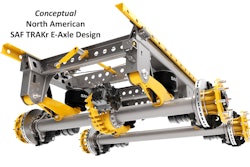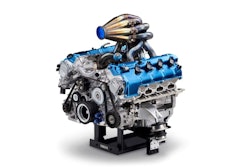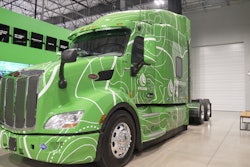Trucking used to be all about shifting.
Manual transmissions were king. Now automated manual transmissions rule.
Downspeeding entered the mix of technology choices. The future zero-emission trucks may have even less visible shifting requirements for the driver. What shifting technology will be optimized for autonomous trucks? I suggest the new Paradigm Shift Transmission. I don’t know what it does, but it's better, cheaper, smoother, automated, more reliable and all those other great marketing terms you would expect.
Paradigm shifts are fundamental to trucking technology change.
I used to cringe every time I heard the word paradigm in meetings. It tends to be one of those expensive words thrown about by marketing people and venture capitalists trying to get attention. A good word so often sacrificed at the altar of salesmanship.
A paradigm shift is a fundamental change in approach or underlying assumptions. A significant one is that being able to drive is no longer a goal for many people.
The percent of young people pursuing driver’s licenses has been decreasing for decades. Conversely, the percent of people above the age of 55 with licenses has been increasing.
Getting around by yourself in your own car used to be a right of passage to adulthood. For many, that is no longer true. Getting around is still vastly important but ride sharing, parents and friends with cars, walking, bicycling and, yes, public transportation have become normal.
The growth of e-commerce and virtual services also have eaten into the need for your own driver’s license and car. No longer do you have to go to the store to get everything. It can come to your door.
The growth of social media and smart phone use have also taken a bite out of driving. A few years ago, I took three high school kids out to dinner and they spent most of the meal face down in their phones communicating by text with each other from across the table. Smartphones are ubiquitous. Social media has enabled communicating at a distance reducing face-to-face interactions.
The price of cars, insurance, fuel, parking, tolls, etc. also has contributed to a lack of ability for younger people to get into owning a vehicle. The U.S. Federal Highway Administration estimates that licensed drivers ages 20 to 24 have dropped from 91.8% in 1983 to 80.1% in 2018. Those aged 18 have dropped from 80.4% in 1983 to just 60.9% in 2018.
These numbers are all pre-COVID. I am guessing that COVID probably impacted them adversely, too. Staying at home probably discouraged people from trying to get a license. Driving schools saw a drop in enrollment during the first half of COVID precautions — both the number of trainers and trainees dropped.
So where is the experienced pool of drivers going to come from for commercial trucking? The “driver shortage” is not just a trucking industry issue. It’s a driving system level issue.
These trends highlight that we need to encourage people to learn to drive. Understanding the root cause of driving disenchantment is critical to having a viable driver pool for all vocations. Making driving desirable again goes beyond the traditional advertising mechanisms of fast, expensive, sexy cars and trucks, because clearly that has not been reversing the trends.
Automation is appealing, across the board from personal vehicles to commercial vehicles, especially for those thought leaders who just don’t like driving. Think about the fact that 20% of 20-24-year-olds don’t have a license and ask yourself where that group will end up as industry leaders in the future. It seems inevitable that as fewer and fewer young people get licenses there will be more dependence on automation. Automated vehicle manufacturers and their investors are salivating over that reality.
What can make driving more appealing to younger people? NACFE has proposed that electric vehicles are one positive step toward making driving more interesting. Think about it. The majority of electric cars are charged at home. The market has spoken that going to a gas station is on the lower end of things car owners want to do with their time. They prefer to drive home, plug in and go into the house.
I suggest that even if instantaneous car charging were available, drivers would still prefer to charge at home rather than go out of route to find and use a charging station. On longer trips they would make use of them, but for the majority of car traffic would you really want to go to a station on your way home, or just go home? In trucking we found that electric vehicle drivers go directly to their truck parking spot, plug in and immediately drive their personal vehicle home at the end of shift. There are no out-of-route miles to get to a fuel station, no fumes, no spilled fuel. The driver’s shift time is spent behind the wheel on revenue generating routes.
Electric vehicles are quiet. The performance is there under the pedal — nearly continuous power at all speeds. Regenerative braking also has made one-pedal driving closer to a reality. A subtle simplification, but an important one.
Shifting, if it even occurs, is invisible to the driver. Drivers of electric vehicle have almost no need to look under the hood. Washer fluid is about it. Tire monitoring systems are largely standard now in cars, so the car tells you when you have a low tire. It’s all about simplifying driving, reducing it to almost a “point and click” experience. Automated driving and safety systems are becoming common with lane keeping assist, automated braking, collision mitigation, blind spot warnings, etc. But is all this simplification making driving more desirable? Or just easier?
Electric vehicles are zero emission. Driving one is a statement that you care about the environment; that you care about the future. Drivers NACFE has interviewed talk about how proud they are to drive electric trucks, they say their families are proud of them, their kids talk about them in school. They are proud to drive for companies that are adopting electric vehicles. Brand image is important to drivers and owners.
All the other performance factors are important, but the exciting part of driving an electric vehicle is that it is responsible. Now there is a paradigm shift.
Rick Mihelic is NACFE’s Director of Emerging Technologies. He has authored for NACFE four Guidance Reports on electric and alternative fuel medium- and heavy-duty trucks and several Confidence Reports on Determining Efficiency, Tractor and Trailer Aerodynamics, Two Truck Platooning, and authored special studies on Regional Haul, Defining Production and Intentional Pairing of tractor trailers.











